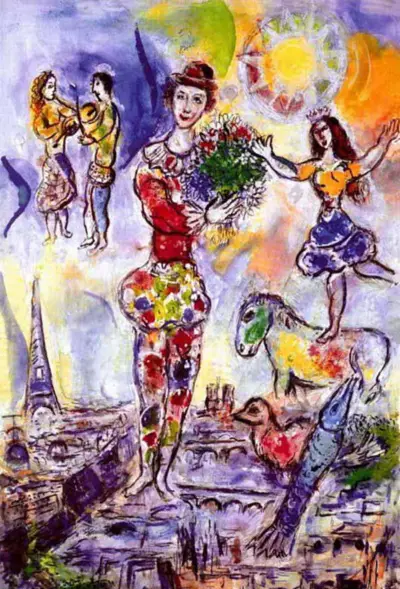The Seine flows through the centre. On the sky are various figures, including a horse, a rooster, a herring or flying fish, a princess rushing in with arms raised, and a fiddler playing the guitar as a girl, presumably his lover, watches in close proximity.
At the centre of all these is a woman with a bouquet in her hands. Floating figures and bouquet of flowers betray Chagall’s hallmark style, and is an instant giveaway to identify his painting.
Marc Zakharovich Chagall is a renowned Russian-French artist, and one of the early modernists.
On the Roof of Paris Is is an iconic representation of Chagall’s distinctive style of using brash colours and fairy-tale imagery. The painting also resonates with his characteristic style of exploring the pictorial space and creating a volume using faceted panes.
Chagall is also at his best in using stylistic tricks to give his objects a veneer of modernity. The painting has wit, imagination and formal adventurousness written all over it.
True to most of Chagall’s paintings which are noted for its deep symbolism, “On the Roof of Paris” is also deep in symbolic meaning. Eiffel Tower, up is the sky is often associated with freedom, though it is a natural fit to the Paris skyline anyway. The horse too symbolises freedom. The rooster typically symbolise love and sex.
Much of Chagall’s imagery and underlying theme betrays wistful images of Eastern European Jewish culture, a throwback to the painter's early life in Russia. “on the roof of Paris” is no exception, with the Herring commemorating Chagall's father work in a fish factory.
The depiction of the fiddler is also a throwback to Chagall's hometown of Vitebsk, where it was customary for a fiddler to make music at key events, such as birth, death, and weddings. Here the connotation is love. However, Chagall himself denies any intended symbolism, leaving each viewer is left to interpret his works according to their own taste.
On the Roof of Paris is a perfect addition to Marc Chagall’s famous 1913 painting “Paris through the window.” Here too the Eiffel Tower, representing freedom, is the distinctive landmarks, set amidst scores of mansard roofs of anonymous buildings.
Inside the window, a human-headed cat perches on the window and stares, a blue-faced, Janus-headed man lurks in a corner. Outside, a parachute-jumper descends as two figures float past, and an upside down train rolls by.
Chagall, the “painter-poet” had little art training before he moved to Paris in 1911, and started on his masterpieces, such as “I and the Village” (1911,) “Half past three” (1911,) “Paris Through the Window” (1913,) "The Promenade" (1918,) “Over the town” (1918,) and more. Through these and later works, Chagall established himself as a leading member of the avant-garde. He toyed with several radical modernist styles, such as Cubism and Surrealism, and worked in an abstract style, all the while remaining deep rooted in figurative and narrative art.
Chagall’s long career spread over seven decades made him among the most familiar and internationally recognised artists among the "School of Paris" group of modernist painters. Works such as “Paris through the Window,” and “On the Roof of Paris” have gone a long way in establishing his reputation.
